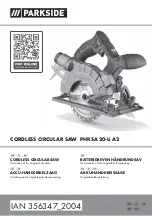
Ripping (Fig 21)
Fig 21
Crosscutting (Fig 22)
Fig 22
Resawing (Fig 23)
Fig 23
For the authorized use of the machine observe the appendix
A
“safe operation“
(on the last pages of this operating manual)
A.1: Performing high cuts
A.2.: Performing diagonal cuts
A.3.: Tenon cutting
A.4.: Cutting of wedges
A.5.: Curved cuts
A.6.: Arc cuts
A.7.: Cutting with template
A.8.: Circular cutting
A8.1 Set up without workpiece
A8.2 Placing the workpiece
A8.3
Machining
7. Setup and adjustments
General note:
Setup and adjustment work may only be carried out after
the machine is protected against accidental starting by
pulling the mains plug.
7.1 Saw blade selection
The sawblade has to meet the technical specification.
Choose a suitable sawblade, according to the cutting
operation and according to the material to be cut.
For a high rip cut:
- use a wide sawblade, coarse teethed
(e.g. 20mm, 3 T/”)
For a narrow curved cut:
- use a narrow sawblade
(e.g. 3mm, 14 T/”).
Pitch:
The pitch should not be smaller than necessary, as the feed
speed is reduced if there are too many teeth working on the
workpiece simultaneously, which causes the saw blade to
wear more quickly.
Ideally, 3 to 12 teeth should be in action at the same time (Fig
24).
Fig 24
The following table shows recommended saw blade pitch in
relation to workpiece thickness (Fig 25).











































